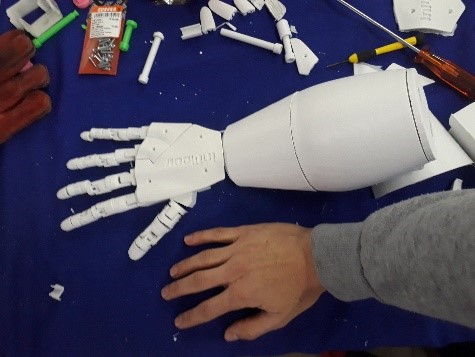3D Printed Humanoid Base for Smart City Research

Dr N Luwes
Introduction
To handle rapid urbanization, there is need to find new ways to manage complexity, increase efficiency, reduce expenses, and improve quality of life. The new ways are rooted in the concept of 'smart city'.
Smart city research is focused on research that can produce new technology, products, devices, structures, methodology contributing towards the development of a Sustainable City of the Future. This research explores the possibilities of the Industrial Revolutions and in particular Industry 4.0.
A big part of industry 4.0 and combined with smart city would see a need for Humanoids. A humanoid robot is a robot with its body shape built to resemble the human body. The design may be for functional purposes, such as interacting with human tools and environments, for experimental purposes, such as the study of bipedal locomotion, or for other purposes. In general, humanoid robots have a torso, a head, two arms, and two legs, though some forms of humanoid robots may model only part of the body, for example, from the waist up. Some humanoid robots also have heads designed to replicate human facial features such as eyes and mouths. Androids are humanoid robots built to aesthetically resemble humans.
Open source designs are constructed, evaluated, improved and implemented. The result is a working humanoid base that is available for research that could focus on movement, interaction and programming.
Problem statement
Humanoid research needs a physical working humanoid base that is also customisable. Humanoid research is not limited to the mechanical build of it but can also include more realistic movement from control programming, gripping and handling, ease of interaction with humanoid in a smart city environment be it physical or physiological

A humanoid arm designed to replicate a human arm
Aim
The purpose is to print and constructing working humanoids bases, “turn key” solution, that can be used for further research in the smart city environment and also as technology demonstrators at fairs and expos. These could be use to show what humanoids role could be in smart city’s.
Future work would include the physiological impact of humanoid assistant (uncanny valley), in other words what changes could be made to the facial and other futures to make it less intimidating, proportional integral derivative controller (PID) of limbs, text to voice and mouth movement and tracing and object recognition for pickup. The Multi, Inter and Trans-disciplinary could utilize a “turn key” system with ease.
Conclusion
Much research must still be done in the humanoid’s role in the new smart city. This do not only include automation and robotics but also the interaction between human and humanoids.
A turn key mechanical platform is constructed in-house to have a base to concentrate only on PID’s and further programming and applications. In house construction ease customization of peripherals such as, the look of the face or other hands and or grippers. The humanoids would be good demonstrators at schools, open days and fairs.

CUT Registrar sets 2026 Registration in motion
CUT News Students LeadershipThis period of the academic cycle is commonly framed in operational terms-registration processes, admissions...

CUT appoints Dr Marcia Lebambo as Director of the Entrepreneurship Development Unit (EDU)
The Central University of Technology (CUT) is proud to welcome Dr Marcia Lebambo as the new Director...

CUT welcomes Mr Galeboe Mogotsi as Chief Information Officer
Galeboe Mogotsi, CUT’s newly appointed Chief Information Officer.The Central University of Technology,...



